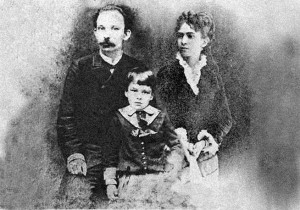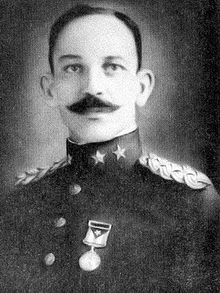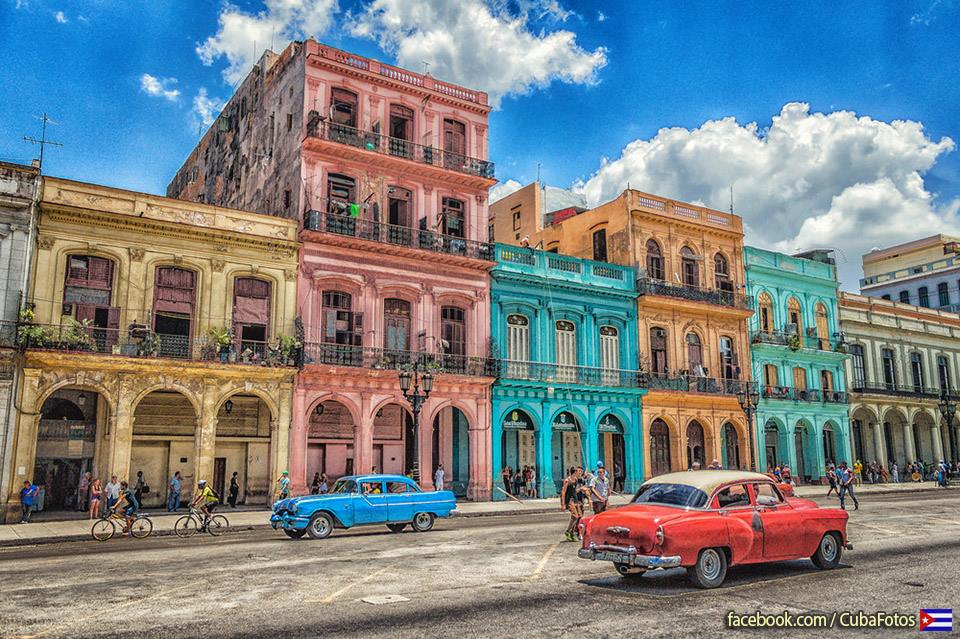 VIDA DE EL HIJO DE JOSÉ MARTÍ: JOSÉ FRANCISCO MARTÍ Y ZAYAS-BAZÁN.
VIDA DE EL HIJO DE JOSÉ MARTÍ: JOSÉ FRANCISCO MARTÍ Y ZAYAS-BAZÁN.

José Francisco Martí y Zayas-Bazán también conocido por los cubanos como El Ismaelillo, Pepito o Pepe, fue un político y militar cubano, hijo de un héroe nacional cubano.
Los padres de José Francisco Martí fueron José Julián Martí y Pérez (José Martí) un joven revolucionario que había estado preso a la edad de 17 años y más tarde desterrado de su país por sus ideas políticas y María del Carmen Zayas-Bazán e Hidalgo hija de un hacendado cubano que debido a la quema de los cañaverales y al conflicto en general de la Guerra de los Diez Años había optado por irse con su familia a vivir en México en 1871. Fue en México, en la casa de Ramón Guzmán donde en febrero de 1875 sus padres se conocieron, pero no fue hasta el 20 de marzo de 1877 que ellos se casaron en la Catedral de México.
José Martí y Carmen viajaron por Acapulco y luego por Guatemala, hasta que el 27 de julio de 1878 regresaron a La Habana vía Honduras, ya que debido a la firma del Pacto del Zanjón podían regresar a su querida Cuba.
En Cuba once meses después de haber contraído matrimonio, Carmen Zayas-Bazán dio a luz a José Francisco Martí, un día 22 de noviembre de 1878. Pero como muy bien reza el dicho “la felicidad dura poco en casa del pobre”, a mediados de 1879, sólo 15 días después de ser bautizado el 6 de abril, su padre es arrestado el 21 de abril de 1879 por sus discursos en El Liceo de Guanabacoa y luego deportado a España el 25 de septiembre de ese mismo año por lo que su madre se lo lleva de la Habana a Puerto Príncipe, Camagüey, a la casa de sus abuelos, Francisco Zayas-Bazán y Varona e Isabel María Hidalgo y Cabanillas, ubicada en la entonces calle San Francisco # 9 actual Antonio Luaces # 104.

En 1881 su padre José Martí se establece en Brooklyn New York por lo que en 1882 Pepito y Carmen se van a vivir con el residiendo por ese entonces en una humilde casita alquilada por el Apóstol. Ese mismo año, su papá le dedicó una hermosa obra llamada El Ismaelillo. En New York vivieron con cierta estabilidad por algún tiempo, pero debido a que su papa era personaje público de la política y debido a los celos de su mamá y la falta de compenetración de sus padres en 1885 regresa con su madre a Cuba.
Sus primeros estudios fueron en el prestigioso Colegio Escolapio San Calasancio situada en la Calle Luaces # 2 convertida actualmente en la Escuela Provincial de Deportes (ESPA) y la Clínica Estomatológica Cerro Pelado.
El 30 de julio de 1891 viaja de nuevo a New York en un intento de su mamá por reconciliarse con su papá pero al llegar Carmen Zayas-Bazán se da cuenta de que José Martí tiene una relación amorosa con Carmen Miyares por lo que dolida por su traición, el 27 de agosto, solo dos meses después de llegar a Brooklyn, con la ayuda de Enrique Trujillo y por medio del Consulado de España en New York regresan a La Habana, para luego establecerse otra vez con sus padres en Camagüey. Esa sería la última vez que El Ismaelillo vería a su padre.
Ese mismo año matricula Derecho en la Universidad de la Habana pero debido a la reciente trágica muerte de su padre en Dos Ríos y tras el infructuoso intento de su madre con el Gobernador General, el General Arderius, por recuperar el cuerpo de su padre, viaja, en septiembre de 1895, junto con su mamá, a New York, para recoger las pertenencias de su papá, desde donde le escribe a Gonzalo de Quesada:
“Mi amor de hijo se ha resistido largo tiempo a creerlo. La horrible realidad se ha impuesto a mi espíritu de tal suerte, que mi pensamiento no puede apartarse de ese dolor (…) Soy hijo y todo lo suyo me es sagrado (…) Tengo 16 años pero las energías todas de mi alma, están dispuestas para llorar a mi padre, como hijo y como cubano.”

En 1897, contra la oposición de su mamá y con solo 18 años de edad se une a la expedición de Carlos Roloff que desembarcó en la costa oeste de Cuba para unirse el 21 de marzo de ese mismo año al Ejército Libertador de Cuba bajo las órdenes del general Calixto García Iñiguez como soldado de artillería. Poco tiempo después, participa en varios combates y recibe el grado de teniente por su arrojo y valentía en la toma de Victoria de Las Tunas , más adelante es ascendido a capitán, grado con el que terminó al concluir la guerra.
José Francisco, después de la guerra y tras la disolución del ejército libertador, trata de incorporarse a la Universidad de La Habana, pero la falta de dinero le impide continuar los estudios, lo que le hace aceptar un cargo como empleado público en la Aduana. Gonzalo de Quesada su amigo y antiguo amigo de su padre, protesta enérgicamente contra el gobierno para que lo incorporen al ejército. Gonzalo de Quesada logra que reincorporen a Pepito, siendo él uno de los oficiales que hacen el cambio de banderas ante la Capitanía General el 20 de mayo de 1902.

En el periodo de 1909 a 1913 bajo el gobierno de José Miguel Gómez fue ascendido, primero a Comandante, después a Coronel y luego a Jefe de Estado Mayor. Posteriormente desempeña el cargo de Secretario de Guerra y Marina y obtiene el grado de General bajo el gobierno de Mario García Menocal entre 1913 y 1921, grado con el que se retira de las Fuerzas Armadas.
En 1915 y a sus 37 años de edad se enamora de María Teresa Bances (Teté), hija única del banquero español Victoriano Bances con quien contrae matrimonio el 21 de febrero de 1916 en la Iglesia Parroquial del Sagrado Corazón de Jesús, del Vedado y Carmelo.Esa unión nunca daría frutos. José Francisco Martí nunca tendría descendientes.
Entre 1926 y 1933 declara su inconformidad contra la tiranía Machadista, haciendo público su “Manifiesto a Cuba” pero al no encontrar una solución ante la feroz represión desatada por Gerardo Machado pasó a formar parte del ABC, con el cargo de Vicepresidente, una organización política secreta y de carácter celular que utilizó la lucha clandestina con el fin de desencadenar la insurrección popular.
El 15 de enero de 1928 José Francisco Martí recibe la peor noticia que un hijo puede recibir, el del fallecimiento de su madre Carmen Zayas-Bazán.
El ABC después del derrocamiento del llamado “Asno con Garras” tomó otra dirección política hasta convertirse en un partido político de gánsteres lo que hizo que José Francisco se retirara del escenario público.
El 22 de octubre de 1945 José Francisco Martí fallece víctima de una prolongada enfermedad pulmonar. En el sepelio por sus méritos archivados a lo largo de su vida, se le otorgan los honores de Mayor General.Hasta ese día vivió feliz junto a su esposa en una casa hecha por Don Victoriano, el padre de su esposa, ubicada en Calzada 807 esquina a 4, Vedado; actual Centro de Estudios Martianos.
José Francisco Martí hasta el día de su muerte nunca utilizó la influencia de su apellido para escalar posiciones en la sociedad, sabiendo, a lo largo del camino de su vida, ganarse todos los méritos que lo hicieron digno de llevar el apellido de su padre.
Agencies/Wiki/Internet Photos/Arnoldo Varona/TheCubanHistory.com
THE CUBAN HISTORY, HOLLYWOOD.

WWW.THECUBANHISTORY.COM
 LIFE OF THE SON OF JOSÉ MARTÍ: JOSÉ FRANCISCO MARTÍ and ZAYAS-BAZÁN.
LIFE OF THE SON OF JOSÉ MARTÍ: JOSÉ FRANCISCO MARTÍ and ZAYAS-BAZÁN.

José Francisco Martí and Zayas-Bazan also known by the Cubans as Ismaelillo, Pepito or Pepe, was a political and military, son of a Cuban National Hero.
His parents were José Julian Marti and Pérez (José Martí) a young revolutionary that had State prisoner to the age of 17 years and more afternoon banished of its country by their ideas political and Maria of the Carmen Zayas-Bazan e Hidalgo daughter of a Squire Cuban that due to it burns of them reeds and to the conflict general of it Guerra of them ten years had opted by go is with your family to live in Mexico in 1871. It was in Mexico, in the House of Ramón Guzmán where in February 1875 his parents met, but it was not until 20 March 1877 that they were married in the Cathedral of Mexico.
José Martí and Carmen traveled by Acapulco and then by Guatemala, until the 27 of July of 1878 returned to it Havana via Honduras, since due to the signature of the Pact of the Zanjón could return to his beloved Cuba.
In Cuba eleven months after having contracted marriage, Carmen Zayas-Bazan gave to light to Jose Francisco Martí, a day 22 of November of 1878. But as very well reza the said “the happiness hard little in house of the poor”, mid 1879, only 15 days after be baptized the 6 of April, his father is arrested the 21 of April of 1879 by their speeches in the Liceo of Guanabacoa and then deported to Spain the 25 of September of that same year by what his mother is it takes of the Havana to port Prince , Camagüey, to the House of its grandparents, Francisco Zayas-Bazan and Varona e Isabel María Hidalgo and Cabanillas, located in the then Street San Francisco # 9 current Antonio Luaces # 104.

In 1881 his father José Martí is set in Brooklyn New York so in 1882 Pepito and Carmen are going to live with the residing at that time in a humble cottage rented by the apostle. That same year, his father dedicated a beautiful play called the Ismaelillo. In New York they lived with some stability for some time, but since his father was public policy and character due to the jealousy of her mother and the lack of mutual understanding of their parents in 1885 returns with his mother to Cuba.
His early studies were at the prestigious Escolapio school San Calasancio located in Calle Luaces # 2 converted currently in the Provincial Sports School (ESPA) and the Cerro Pelado stomatological clinic.
On 30 July 1891 he travels back to New York in an attempt to his mother to reconcile with his father but arriving Carmen Zayas-Bazán realizes that José Martí has an affair with Carmen Miyares so grieved by his betrayal, on 27 August, only two months after arriving in Brooklyn , with the help of Enrique Trujillo and by means of the Consulate of Spain in New York return to the Havana, for then set is another time with their parents in Camagüey. That would be the last time that the Ismaelillo would see his father.
That same year registration law in the University of Havana, but due to the recent tragic death of his father in two rivers and after the unsuccessful attempt of his mother with the Governor General, the General Arderius, to retrieve the body of his father, travels, in September 1895, along with her mother, to New York, to collect the belongings of his father , from where you writes to Gonzalo de Quesada:
“My love’s son has resisted long time to believe it. The awful reality is has tax to my spirit of such luck, that my thinking not can set aside is of that pain (…) I am child and all it his me is sacred (…) “I have 16 years but the powers are all of my soul, ready to mourn my father, as son, and as Cuban.”

In 1897, against the opposition of his breast and with only 18 years of age is une to the expedition of Carlos Roloff that landed in the coast West of Cuba for join is the 21 of March of that same year to the army Libertador of Cuba low them orders of the general Calixto Garcia Iñiguez as soldier of artillery. Shortly afterwards, he participated in several battles and received the rank of Lieutenant for his bravery and courage in making of Victoria de Las Tunas, is later promoted to captain, grade that ended at the end of the war.
Jose Francisco, after the war, and after the dissolution of the liberating army, is joining the University of Havana, but lack of money prevents him from continuing studies, making him to accept a position as a civil servant in the customs. Gonzalo de Quesada his friend and old friend of his father, protest vigorously against the Government so that they join the army. Gonzalo de Quesada accomplished that they return to Pepito, still one of the officers making the change of flags to the captaincy General of May 20, 1902.

In the period from 1909 to 1913 under the rule of José Miguel Gómez he was promoted, first to major, then Colonel and then Chief of staff. Later plays the charge of Secretary of Guerra and Marina and obtained the grade of General under the Government of Mario Garcia Menocal between 1913 and 1921, grade with which is removed of them forces armed.
In 1915, and at 37 years of age falls for María Teresa Bances (Teté), only daughter of the Spanish banker Victoriano Bances with whom he married on February 21, 1916, in the Church parish of the sacred heart of Jesus, of the Vedado and Carmelo.Esa union would never give fruit. José Francisco Martí would never have descendants.
Between 1926 and 1933 stated their dissatisfaction against the tyranny Machadista, making public its “manifesto to Cuba” but not finding a solution before the ferocious repression unleashed by Gerardo Machado it became part of the ABC, with Vice President, a secret political organization of cell character that used the clandestine struggle in order to trigger the popular insurrection.
On January 15, 1928 José Francisco Martí Gets the worst news that a child may receive, on the death of his mother Carmen Zayas-Bazán.
The ABC after the overthrow of the called “ass with claws” took another address political to convert is in a party political of gangsters what made that Jose Francisco is withdraw of the stage public.
The 22 of October of 1945 José Francisco Martí died victim of a prolonged disease pulmonary. In the funeral by their merits archived along its life, is you give them honors of greater General.Hasta that day lived happy next to his wife in a house made by Don Victorian, the father of his wife, located in booted 807 corner to 4, Vedado; current Centro de Estudios Martianos.
José Francisco Martí until the day of his death never used the influence of his surname to climb positions in society, knowing the path of his life, win all the merits that made it worthy of carrying the surname of their father.
Agencies / Wiki / Internet Photos / Arnoldo Varona / TheCubanHistory.com
THE CUBAN HISTORY, HOLLYWOOD.

CUBA HOY/TODAY.
 Livia Brito Pestana (La Havana, Cuba, July 21, 1986) is a Cuban actress who debuted in Mexico in 2010 and became known in his role as Fernanda Sandoval in Triumph of Love.
Livia Brito Pestana (La Havana, Cuba, July 21, 1986) is a Cuban actress who debuted in Mexico in 2010 and became known in his role as Fernanda Sandoval in Triumph of Love.



















